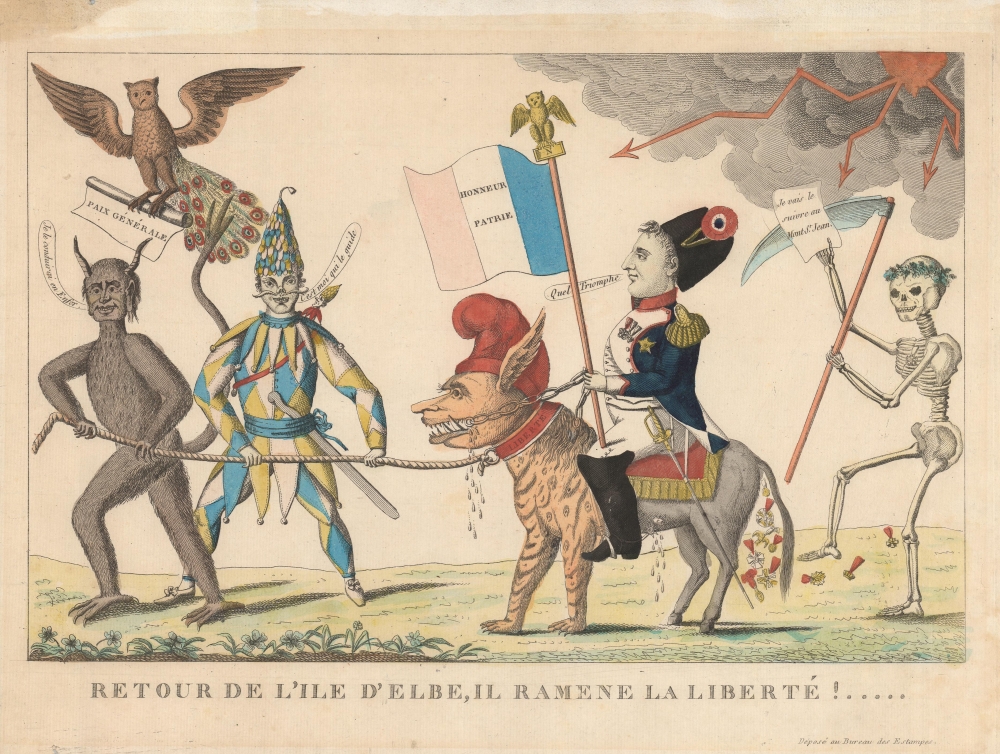1815 Genty Satire of Napoleon's Return from Elba
RetourElbeNapoleon-genty-1815
Title
1815 (undated) 10.75 x 14.25 in (27.305 x 36.195 cm)
Description
A Closer Look
Napoleon rides a beast whose front is a tiger wearing the red cap of the Sans Culottes and whose rear is that of a donkey. His spurs draw blood from the animal, which is defecating military medals as it walks. A demon and jester pull the animal, stating 'I will lead him to Hell' and 'I am the guide,' respectively. Behind Napoleon is a skeleton representing Death, holding a banner 'I will follow him to Mont St. Jean,' that is, Waterloo, indicating that the print was produced after that decisive battle. Oblivious to his future demise, Napoleon claims 'What a triumph.'This work is one of a series of contemporary satirical prints depicting Napoleon's escape and attempts to reestablish power, including Thomas Rowlandson's 'The Flight of Bonaparte from Hell-Bay' and George Cruikshank's 'Escape of Buonaparte from Elba.' Following Napoleon's second exile, on St. Helena, Genty produced another work skewering the recent emperor titled 'Je Fume en Pleurant mes Péchés'. Given the political instability in France, most Napoleonic satires were published abroad, especially in Britain, making this work especially significant.
Napoleon's Return - the 'Hundred Days'
One of the most dramatic political comebacks in history, one which nevertheless ended in failure, was Napoleon Bonaparte's escape from exile on Elba and return to Paris. Following his disastrous invasion of Russia in 1812, Napoleon's depleted army was on the defensive against the forces of the 'Sixth Coalition' through 1813 and early 1814, losing several consecutive large battles, including the massive 'Battle of the Nations' at Leipzig in October 1813. Though Napoleon won several smaller battles, he was not able to overcome the numerically far superior Coalition troops, and Paris was captured after a brief battle on March 31, 1814.Napoleon was deposed as emperor and sent to exile on Elba, according to the Treaty of Fontainebleau. This agreement allowed Napoleon a degree of freedom and recognition (the island became a sovereign principality ruled by him). As the Congress of Vienna dragged on and members of the victorious coalition clashed with each other, especially over the fate of Poland and Saxony, and as France bristled at the loss of its prestige and empire, Napoleon began to plot his return, expecting that the French public would rally to him against the restored Bourbon monarchy ruling the country after his fall.
Choosing an opportune moment, Napoleon slipped away from Elba on February 26, 1815, and landed at Cannes with a small force. As he predicted, the remnant French army, nominally loyal to the restored Bourbon monarchy, readily switched allegiance to him, and he triumphantly entered Paris on March 14. Both France and members of the coalition (now the Seventh Coalition) formed armies, preparing for another invasion of France. Napoleon aimed to win by attacking Coalition forces in Belgium before they could coalesce, and initially, the plan seemed to succeed. But Wellington's stand on June 18 at Waterloo, reinforced by Blücher's Prussian force, routed the French Army and led to Napoleon's second abdication and the decisive end of his empire.
Publication History and Census
Though not named here, this print is attributed to the Parisian satirist and printer Genty. It is undated, but from context can be dated to mid-late 1815, after the Battle of Waterloo. It is a scarce work, with known examples being held by the Museo Nazionale delle Residenze Napoleoniche dell'Isola d'Elba, the Bibliothèque nationale de France, the Musée Carnavalet, the British Museum, the University of Oxford, Harvard University, and the University of Washington. The example held by the Musée Carnavalet includes additional publication information at bottom-left in the margin ('Se vend à Paris chez Genty, Rue St. Jacques, No. 14.'), which is obscured here and on other known examples, likely to protect Genty from possible political recriminations. There is no known history of this work on the market.Cartographer
Genty (fl. c. 1814 - 1834) was a Parisian printer especially known for his caricatures and political satires. Little is known about his life and training. Earlier scholars speculated that he may be the same as the portrait artist (miniaturist) Jean Baptiste Genty (c. 1770 - 1834), but later research has shown this to be most likely erroneous. Given the political nature of many of his satires, Genty often signed his works with oblique references such as 'marchand d'estampes' or 'chez tour les marchands de nouveautés.' More by this mapmaker...

